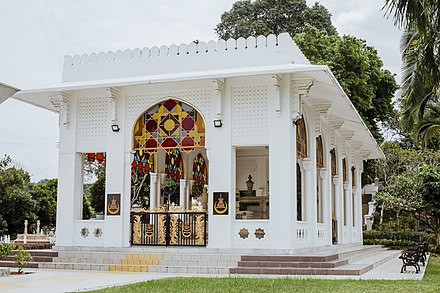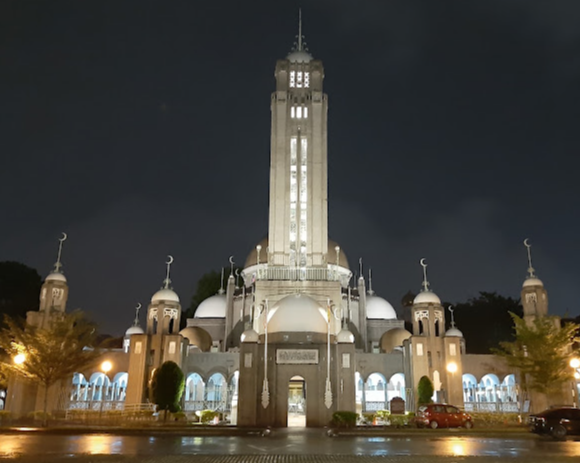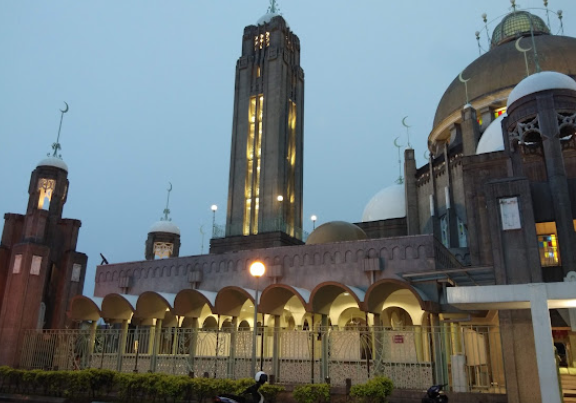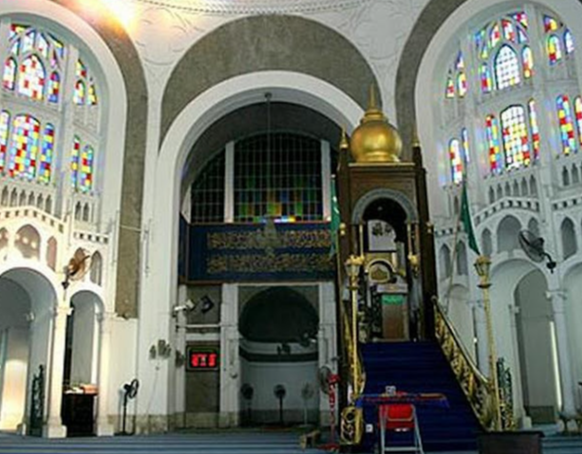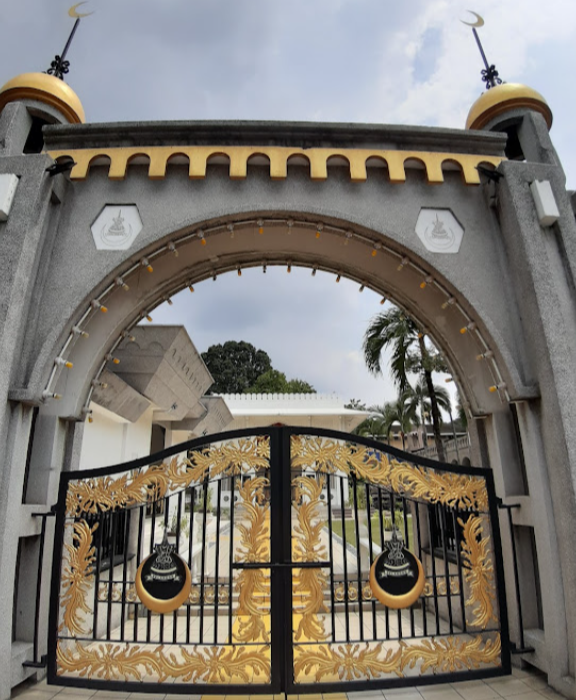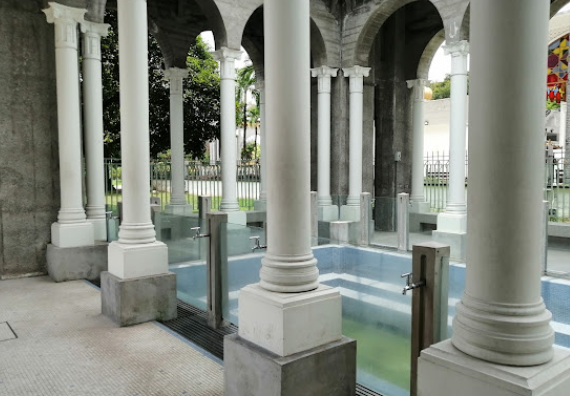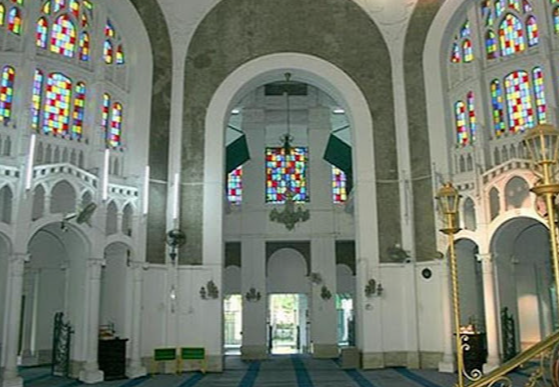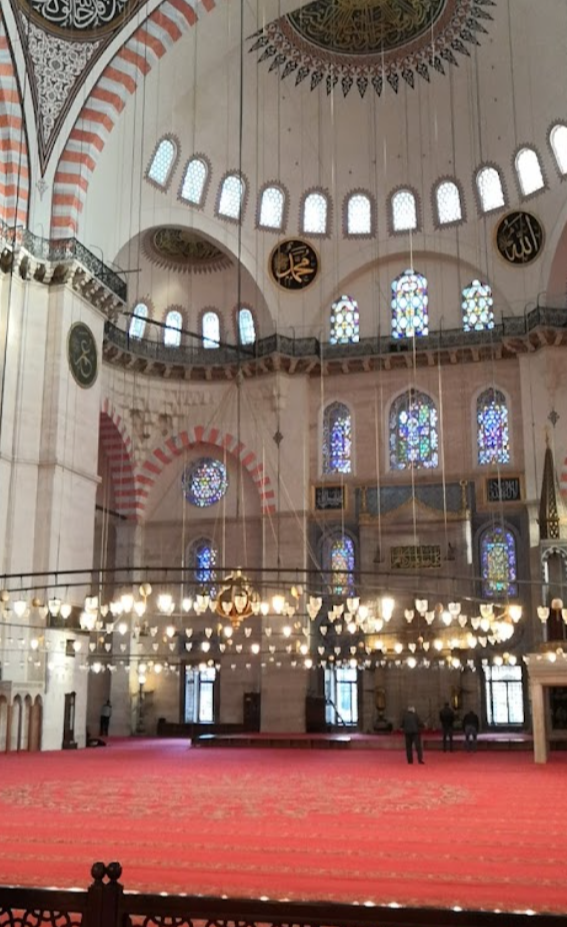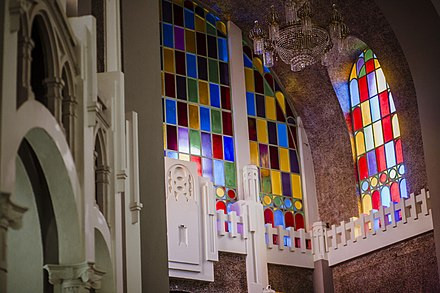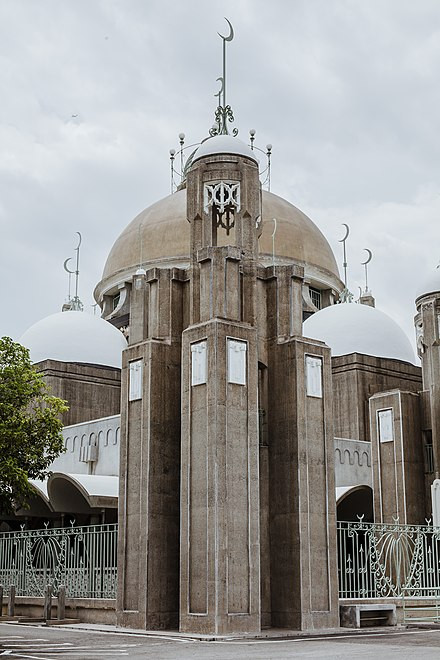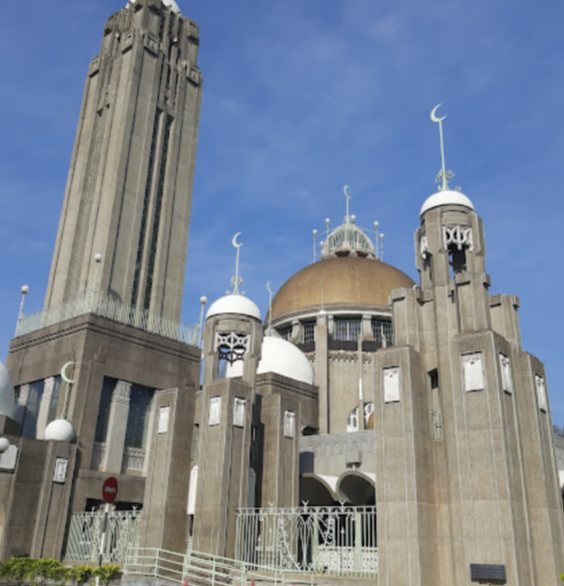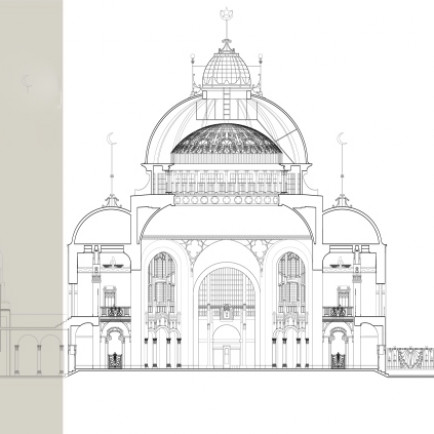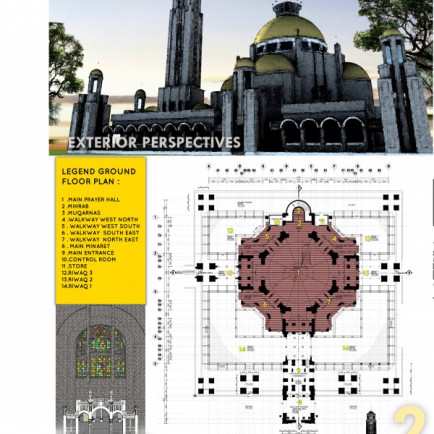Sultan Sulaiman Royal Mosque
History
Sultan Sulaiman Mosque was given as a gift by the British Government to then-Sultan of Selangor, Sultan Sulaiman Alaeddin Shah to commemorate the declaration of Klang as a royal town and to replace the old and unsafe Pengkalan Batu Mosque which was demolished during the construction of Klang train station. He laid the foundation stone of this mosque in 1932.
According to history, before the building of the mosque commenced, a groundbreaking, qibla determination, and prayer ceremony was performed. This ceremony, attended by royalties, government officials, religious figures, architects and British officers, amongst others, was held in order to accurately pinpoint the position of qibla, or the direction towards the Kaaba in the Sacred Mosque in Mecca. The method used was through observing the shadows cast by vertical objects.
The mosque was officiated on 23 June 1933 by the Sultan, during a ceremony attended by the public as well as some prominent guests including the Raja Muda of Selangor, TS Adams (The British Resident of Selangor), L. Kesteven (the architect of the mosque), Raja Haji Othman (Chief Kadhi) besides various Malay chiefs, religious officers and European officials. During its opening, the mosque was reportedly the largest mosque in the then-Federated Malay States. Originally, this mosque was known as Masjid Suleiman Jamiur Rahman and it served as Selangor's state mosque until the completion of Sultan Salahuddin Abdul Aziz Mosque in Shah Alam in 1988. The Sultan Sulaiman Mosque remained as the royal mosque.
In May 2012, the mosque was declared a National Heritage Building under the National Heritage Act 2005 (Act 645). The building underwent a number of upgrades and renovations in 1933, 1949, 1953-54, 1958, 1966, 1968, 1970s, 1980s, 1990s and 2000s. Between March 2015 and October 2017, the mosque was closed to the public for restoration works that cost 12 million ringgit and aimed to retain the original architecture and design of the mosque. The conservation project involved processes that included the cleaning of the mural surfaces, treatments to strengthen the murals and painting some parts of the mosque including in the main prayer room.
Urban and Architectural
The design concept of the Sultan Sulaiman Mosque is quite different from other mosques in the state, as well as in the rest of Malaysia's as it notably exhibits a combination of influences of Islamic architecture, Moorish, English, Neoclassical cathedral, and most importantly, Western Art Deco styles. It was designed by the British architect Leofric Kesteven (1882-1974), who was the Chairman of the Malayan Institute of Architects from 1931 to 1933, along with John Thomas Chester, the reinforced concrete specialist attached to United Engineers Ltd; and Rodolfo Nolli, the Singapore-based Italian sculptor who worked on the ornaments of the building.
The semicircular-shaped dome of the mosque is painted in egg yellow, not gold. The large dome of the main prayer space is surrounded by four smaller domes. The main dome represents the Sultan of Selangor while the smaller domes refer to Dato' Besar Empat Suku Selangor. Five domes at the main entrance of the mosque symbolise the Five Pillars of Islam and five Daeng Brothers, while two umbrella-shaped domes are symbolic of the royal umbrella.
There are eight smaller towers around the mosque and a large tower in the middle, with a higher entrance from the main porch. The tower is also decorated with yellow dome at the summit. The original design of the mosque was like a cross bar when viewed from above, as is so often used in church plans in Europe, but after renovations by the Selangor Islamic Religious Department (JAIS), the mosque now has a square footprint.
The present mosque has been through a number of processes and internal modifications; the most recent restoration was completed in 2017, which restored 70 panels of its colourful original bas-reliefs, which were covered with cement and white paint, which is the only kind found in mosques around Malaysia. The bas-reliefs feature the natural scenery and plants of Klang District. They are coloured brightly using hues of red, yellow, blue, and green.
The main prayer room Sultan Sulaiman Mosque is octagonal at the bottom, but it slowly smoothens into a circle at a height of 10 meters. The upper floors can be accessed with 'catladder'. There are decorative iron frames under the dome that support the multi-coloured patterned glass.
Description
The Sultan Suleiman Royal Mosque is Selangor’s Royal Mosque, which is located in Klang. It was designed by the British Architect L.Keste Vend in the early 1930s, and was officiated in 1932 by the late Almarhum Sultan Sir Alaedin Suleiman Shah of Selangor along with the British’s Federated Malay States High Commissioner Sir Lawrence Nuuns Guillemard. The mosque’s architecture is a combination of Western Art Deco and Neoclassical styles. Among the attractive features are the Tangga Diraja (royal stairs) from Istana Alam Shah and a royal mausoleum, where the late Sultan Salahuddin is laid to rest.
Details
Location
Jalan Raya Timur, Kawasan 1, 41000 Klang, Selangor, Malaysia
Worshippers
1000
Owners
Almarhum Sultan Sir Alaeddin Sulaiman Shah
Architect Name
Year of Build
1933
Area
2000
Drawings
Map
History
Sultan Sulaiman Mosque was given as a gift by the British Government to then-Sultan of Selangor, Sultan Sulaiman Alaeddin Shah to commemorate the declaration of Klang as a royal town and to replace the old and unsafe Pengkalan Batu Mosque which was demolished during the construction of Klang train station. He laid the foundation stone of this mosque in 1932.
According to history, before the building of the mosque commenced, a groundbreaking, qibla determination, and prayer ceremony was performed. This ceremony, attended by royalties, government officials, religious figures, architects and British officers, amongst others, was held in order to accurately pinpoint the position of qibla, or the direction towards the Kaaba in the Sacred Mosque in Mecca. The method used was through observing the shadows cast by vertical objects.
The mosque was officiated on 23 June 1933 by the Sultan, during a ceremony attended by the public as well as some prominent guests including the Raja Muda of Selangor, TS Adams (The British Resident of Selangor), L. Kesteven (the architect of the mosque), Raja Haji Othman (Chief Kadhi) besides various Malay chiefs, religious officers and European officials. During its opening, the mosque was reportedly the largest mosque in the then-Federated Malay States. Originally, this mosque was known as Masjid Suleiman Jamiur Rahman and it served as Selangor's state mosque until the completion of Sultan Salahuddin Abdul Aziz Mosque in Shah Alam in 1988. The Sultan Sulaiman Mosque remained as the royal mosque.
In May 2012, the mosque was declared a National Heritage Building under the National Heritage Act 2005 (Act 645). The building underwent a number of upgrades and renovations in 1933, 1949, 1953-54, 1958, 1966, 1968, 1970s, 1980s, 1990s and 2000s. Between March 2015 and October 2017, the mosque was closed to the public for restoration works that cost 12 million ringgit and aimed to retain the original architecture and design of the mosque. The conservation project involved processes that included the cleaning of the mural surfaces, treatments to strengthen the murals and painting some parts of the mosque including in the main prayer room.
Urban and Architectural
The design concept of the Sultan Sulaiman Mosque is quite different from other mosques in the state, as well as in the rest of Malaysia's as it notably exhibits a combination of influences of Islamic architecture, Moorish, English, Neoclassical cathedral, and most importantly, Western Art Deco styles. It was designed by the British architect Leofric Kesteven (1882-1974), who was the Chairman of the Malayan Institute of Architects from 1931 to 1933, along with John Thomas Chester, the reinforced concrete specialist attached to United Engineers Ltd; and Rodolfo Nolli, the Singapore-based Italian sculptor who worked on the ornaments of the building.
The semicircular-shaped dome of the mosque is painted in egg yellow, not gold. The large dome of the main prayer space is surrounded by four smaller domes. The main dome represents the Sultan of Selangor while the smaller domes refer to Dato' Besar Empat Suku Selangor. Five domes at the main entrance of the mosque symbolise the Five Pillars of Islam and five Daeng Brothers, while two umbrella-shaped domes are symbolic of the royal umbrella.
There are eight smaller towers around the mosque and a large tower in the middle, with a higher entrance from the main porch. The tower is also decorated with yellow dome at the summit. The original design of the mosque was like a cross bar when viewed from above, as is so often used in church plans in Europe, but after renovations by the Selangor Islamic Religious Department (JAIS), the mosque now has a square footprint.
The present mosque has been through a number of processes and internal modifications; the most recent restoration was completed in 2017, which restored 70 panels of its colourful original bas-reliefs, which were covered with cement and white paint, which is the only kind found in mosques around Malaysia. The bas-reliefs feature the natural scenery and plants of Klang District. They are coloured brightly using hues of red, yellow, blue, and green.
The main prayer room Sultan Sulaiman Mosque is octagonal at the bottom, but it slowly smoothens into a circle at a height of 10 meters. The upper floors can be accessed with 'catladder'. There are decorative iron frames under the dome that support the multi-coloured patterned glass.
Description
The Sultan Suleiman Royal Mosque is Selangor’s Royal Mosque, which is located in Klang. It was designed by the British Architect L.Keste Vend in the early 1930s, and was officiated in 1932 by the late Almarhum Sultan Sir Alaedin Suleiman Shah of Selangor along with the British’s Federated Malay States High Commissioner Sir Lawrence Nuuns Guillemard. The mosque’s architecture is a combination of Western Art Deco and Neoclassical styles. Among the attractive features are the Tangga Diraja (royal stairs) from Istana Alam Shah and a royal mausoleum, where the late Sultan Salahuddin is laid to rest.


